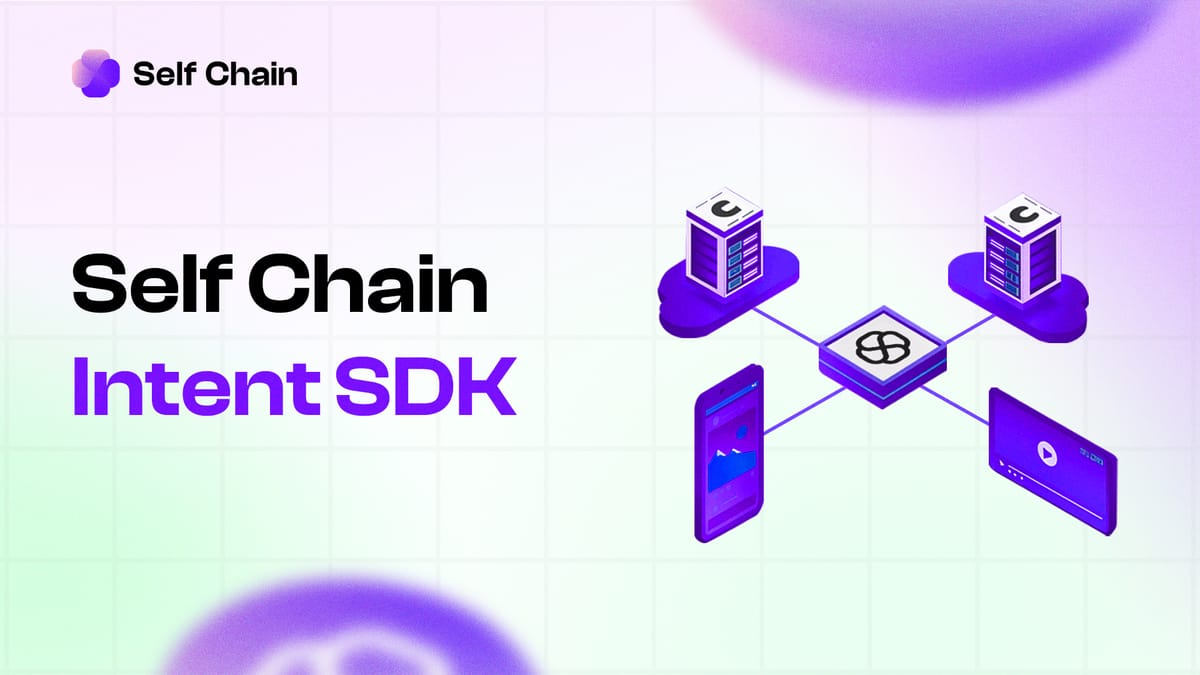Building Smarter Web3 Apps with Self Chain’s Intent SDK

As blockchain ecosystems expand across chains, modules, and execution layers, the challenge isn't just building, it's simplifying. Developers today must navigate increasing complexity while still delivering on security, control, and composability.
The Self Chain Intent SDK is designed to meet that challenge head-on.
By offering a programmable interface into Self Chain’s intent-centric infrastructure, the SDK allows developers to build intuitive, goal-based workflows that operate seamlessly across chains and modules, all without burdening users with the technical steps behind the scenes.
This article unpacks the structure of the Intent SDK, what it enables, and why it’s a foundational tool for building modular, AI-compatible Web3 applications.
Understanding the Role of Intents
In traditional dApp design, user interaction follows a procedural pattern; each transaction requires explicit user direction, specific chain context, and manual signing at every step. This model has proven brittle in cross-chain contexts and fundamentally incompatible with automation, delegation, or agent-driven interactions.
The intent model changes that. An Intent is a declarative expression of a user’s desired outcome, such as swapping tokens, staking assets, or initiating a recurring payment, without prescribing the specific steps or protocols needed to achieve it.
The Self Chain infrastructure interprets, routes, and executes these Intents using a modular stack that includes AI agents, chain abstraction, and universal account management. At the heart of this stack lies the Intent SDK, which allows developers to build this directly into their applications.
What the Intent SDK Enables
The Intent SDK exposes a high-level programming interface that connects applications to Self Chain’s native intent routing architecture.
Here’s what it enables:
→ Intent-Based Interactions: The SDK enables apps to support natural, goal-oriented interactions. Users can express complex flows, like “swap and stake” in a single phrase, which agents then deconstruct and execute.
→ AI-Powered Decomposition and Automation: Intents are parsed and interpreted by Self Chain’s agent layer, which breaks them into actionable tasks and maps the most optimal execution path across chains and protocols with the aid of chain abstraction, solvers and searchers.
→ Faster Shipping Cycles: Instead of managing complex infra like bridges, complex wallet building, developers can focus on defining user goals. The SDK takes care of interpretation, decomposition, and delivery.
→ Optimal Cross-Chain Routing: As the SDK is integrated into any application, developers can access the searchers linked to intent operations to automate pathfinding across 100+ chains. Liquidity fragmentation is abstracted away through smart routing and solver coordination.
→ Lower Costs: With the SDK plugged into any dApp, it will enable bundled execution and sponsored gas to reduce the cost of interacting across chains. Developers don’t need to worry about gas UX as Self Chain handles that under the hood.
→ Universal Access Layer: With multi-chain account abstraction, apps built using the Intent SDK can operate across domains with a single account model, bringing seamless interoperability and reducing overhead.
By integrating the SDK, developers shift from orchestrating low-level blockchain transactions to building high-level user experiences driven by outcomes.
This model abstracts not just the execution mechanics, but the very architecture of interaction.
Why the Intent SDK Is Essential Infrastructure
The SDK isn’t just a development tool, it’s a framework that aligns with the future of blockchain interaction.
In a modular world, where chains serve specialized roles and execution moves fluidly across environments, the need for abstracted, outcome-based interfaces is critical. The Self Chain Intent SDK enables that transition. It empowers developers to create dApps that are:
- Chain-agnostic by default
- AI-compatible for smart automation
- User-centric through declarative input and streamlined UX
It also allows developers to tap into Self Chain’s broader ecosystem of AI agents, universal accounts, and execution modules, all through a consistent, scalable programming model.
Conclusion
The Intent SDK is a critical component of Self Chain’s roadmap. It reflects the chain’s commitment to developer-first infrastructure that is compatible with AI, automation, and abstracted access.
Future versions of the SDK are expected to include domain-specific extensions for DeFi, payments, gaming, and cross-chain identity systems, and other necessary updates.
As Web3 moves toward modular infrastructure and agent-led execution, the Intent SDK will enable developers to build systems that are not only smarter and safer, but fundamentally easier to use.
About Self Chain
Self Chain is the AI-powered intent layer for Web3, and a Modular L1 simplifying blockchain interactions. By combining keyless wallets (MPC-TSS/AA), intent-driven automation, and seamless multi-chain access, Self Chain eliminates complexity, making Web3 more intuitive, autonomous, and secure.
With Keyless Wallets and AI-powered intent execution, users can seamlessly onboard, manage assets, and interact with dApps without handling private keys or complex transactions. Self Chain’s AgentFi Infra enables autonomous on-chain AI agents to execute transactions, optimize DeFi strategies, and interact across ecosystems, while PayFi powers seamless, real-time blockchain payment systems, aligning with the evolving demands of the emerging global economy. Developers benefit from tools like the Intent SDK, Keyless Wallet SDK, and Account Abstraction Plugins, enabling the next generation of AI-driven applications with enhanced security and efficiency.
